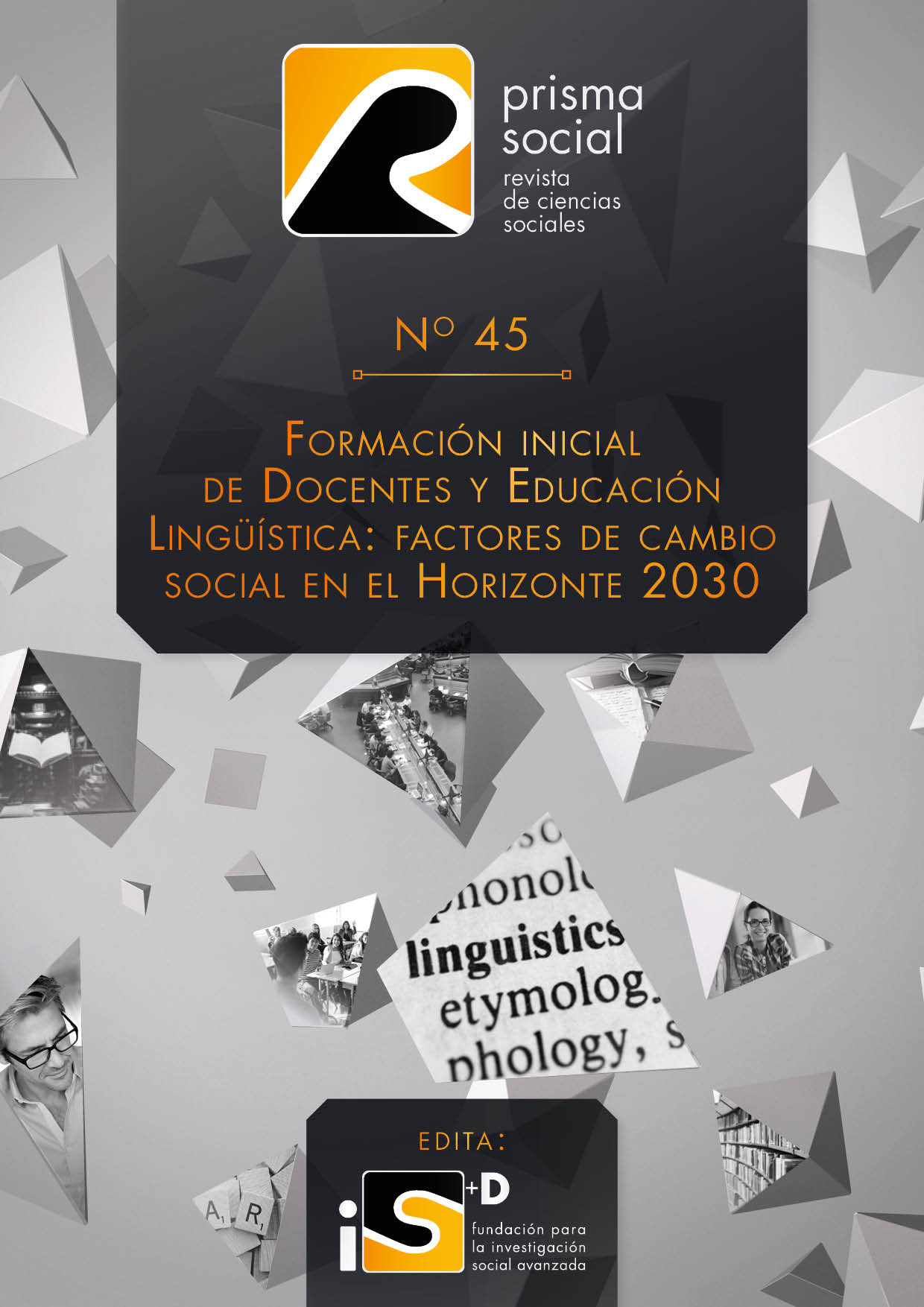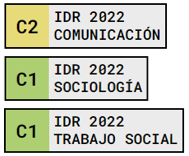Detección y acción sobre la violencia que sufren las mujeres sin hogar
Abriendo un camino de luz
Palabras clave:
Mujeres sin hogar, Violencias, Exclusión, ODS, ETHOSResumen
Las Naciones Unidas han puesto de manifiesto desde hace tiempo que la violencia que sufren las mujeres es una de las violaciones de Derechos Humanos más generalizada del mundo. Esta violencia igualmente se extiende a colectivos más ocultos como son las mujeres sin hogar.
Este artículo vincula la Agenda 2030, en concreto los Objetivos de Desarrollo Sostenible 1, 2, 3, 5, 8, 10 Y 16, como elementos imprescindibles en los procesos de intervención social con mujeres sin hogar, con el programa "Luziérnagas", iniciativa que lleva a cabo la Fundación Luz Casanova en Madrid, para promover la inclusión social y laboral de las mujeres en situación de sinhogarismo, abordando específicamente las experiencias de violencia.
El análisis de la información recopilada sobre este programa y la valoración que hacen del mismo las y los profesionales que trabajan en este área, arrojan como principal resultado la importancia de considerar las violencias sufridas por estas mujeres como variables claves en los procesos integrales de intervención social con ellas. Si dichas violencias no se abordan en profundidad, los esfuerzos en áreas tan importantes como la laboral o la residencial pueden caer en saco roto.
Descargas
Citas
Avramov, D. (Ed.) (1997) Housing Exclusion in Central and Eastern Europe. FEANTSA.
Bourgois, P, Prince, B. y Moss, A. (2004) The everyday violence of hepatitis C among young women who inject drugs in San Francisco. Human Organization, 63(3), 253–264. https://doi.org/10.17730/humo.63.3h1phxbhrb7m4mlv0
Busch-Geertsema V., Culhane D. y Fitzpatrick S. (2016). Developing a global framework for conceptualizing and measuring homelessness. Habitat International, 55, 124–132 https://doi.org/10.1016/j.habitatint.2016.03.004
Calvo, F., Watts, B., Panadero, S., Giralt, C., Rived-Ocaña, M. y Carbonell, X. (2022). The Prevalence and Nature of Violence Against Women Experiencing Homelessness: A Quantitative Study. Violence Against Women, 28(6-7), 1464-1482. https://doi.org/10.1177/10778012211022780
Farley, M., Lynne, J. y Cotton, A. J. (2005) Prostitution in Vancouver: Violence and the Colonization of First Nations Women. Transcultural psychiatry, 42(2), 242–271. https://doi.org/10.1177/1363461505052667
FEANTSA (2007) FEANTSA Proposal: A Retrospective Module on Homelessness for Household Surveys. FEANTSA.
Flentje, A., Leon, A., Carrico, A., Zheng, D. y Dilley, J. (2016) Mental and Physical Health among Homeless Sexual and Gender Minorities in a Major Urban US City. Journal of Urban Health, 93(6), 997–1009. https://doi.org/10.1007/s11524-016-0084-3
Greenfield, B., Alessi, E. J., Manning, D., Dato, C. y Dank, M. (2021) Learning to endure: A qualitative examination of the protective factors of homeless transgender and gender expansive youth engaged in survival sex. International Journal of Transgender Health, 22(3), 316-329. https://doi.org/10.1080/26895269.2020.1838387
Hanley, J., Ives, N., Lenet, J., Hordyk, S. R., Walsh, C., Ben Soltane, S. y Este, D. (2019), Migrant women’s health and housing insecurity: an intersectional analysis. International Journal of Migration, Health and Social Care, 15(1), 90-106. https://doi.org/10.1108/IJMHSC-05-2018-0027
Herrero Fernández, I. (2003) Mujeres sin hogar y violencia de género: la triple invisibilidad. Cuadernos de Trabajo Social, 16, 265-268. https://doi.org/10.5209/CUTS.8664
Huey, L., Broll, R., Hryniewicz, D. y Fthenos, G. (2014) “They Just Asked Me Why I Became Homeless”: “Failure to Ask” as a Barrier to Homeless Women’s Ability to Access Services Post-Victimization. Violence and Victims, 29 (6). https://doi.org/10.1891/0886-6708.VV-D-12-00121
INE (2022) Encuesta a las personas sin hogar. Instituto Nacional de Estadística. https://ine.es/prensa/epsh_2022.pdf
Johnson, J.M (2002) In-Depth Interviewing. En Gubrium, J.F. y Holstein, J.A. (eds) Handbook of interview research (pp. 103-120). Sage.
Kushel, M.B., Evans, J.L., Perry, S.M., Robertson, M.J., y Moss, A.R. (2003). No door to lock: victimization among homeless and marginally housed persons. Archives of internal medicine, 163(20), 2492-2499. https://doi.org/10.1001/archinte.163.20.2492
Mostowska, M. y D?bska, K. (2020) An ambiguous hierarchy of inequalities. The political intersectionality of older women’s homelessness in Poland, Journal of Gender Studies, 29(4), 443-456, https://doi.org/10.1080/09589236.2020.1716699
Naciones Unidas (1993). Declaración sobre la eliminación de la violencia contra la mujer. https://www.ohchr.org/es/instruments-mechanisms/instruments/declaration-elimination-violence-against-women
Nyamathi A. M., Leake B. y Gelberg L. (2000). Sheltered versus nonsheltered homeless women: Differences in health, behavior, victimization, and utilization of care. Journal of General Internal Medicine, 15(8), 565–572. https://doi.org/10.1046/j.1525-1497.2000.07007.x
O’Brien, A. (2023): Homelessness as a Feminist Issue: Revisiting the 1970s, Australian Feminist Studies, 37(112), 134-151. https://doi.org/10.1080/08164649.2023.2173140
Ponce, A.N., Lawless, M.S. y Rowe, M. (2014) Homelessness, Behavioral Health Disorders and Intimate Partner Violence: Barriers to Services for Women. Community Mental Health Journal, 50(7), 831–840. https://doi.org/10.1007/s10597-014-9712-0
Price, H. y Glorney, E. (2022). The challenge to survive: trauma, violence and identity in the lived experience of homeless women. The Journal of Forensic Practice, 24(4), 436-452. https://doi-org.crai-ustadigital.usantotomas.edu.co/10.1108/JFP-04-2022-0018
Reid, N., Kron, A., Rajakulendran, T., Kahan, D., Noble, A., y Stergiopoulos, V. (2021). Promoting Wellness and Recovery of Young Women Experiencing Gender-Based Violence and Homelessness: The Role of Trauma-Informed Health Promotion Interventions. Violence Against Women, 27(9), 1297-1316. https://doi.org/10.1177/1077801220923748
Riley, E. D., Vittinghoff, E., Kagawa, R. M. C., Raven, M. C., Eagen, K, V., Cohee, A., Dilworth, S. E y Shumway, M. (2020) Violence and Emergency Department Use among Community-Recruited Women Who Experience Homelessness and Housing Instability. Journal of Urban Health, 97(1), 78–87. https://doi.org/10.1007/s11524-019-00404-x
Rosa, A. S. y Brêtas, A. C. P. (2015) A violência na vida de mulheres em situação de rua na cidade de São Paulo, Brasil. Interface: Communication, Health, Education, 19(53), 275-285. https://doi.org/10.1590/1807-57622014.0221
Rubio, E.M., García-Santesmases, A. y García-Castilla, F.J. (2024) Interseccionalidad y trabajo social: un encuentro necesario. En Rubio, E.M., Pérez-Viejo, J.M., García-Castilla, F.J. y de la Peña, L. (coords) La Interseccionalidad: un enfoque clave para el trabajo social (pp. 19-34). Dykinson.
Stake, R. E. (2005) Investigación con estudio de casos. Morata.
Tardón, B., Pérez-Viejo, J.M. y Martín de la Peña, L. (2024) Violencia hacia las mujeres y trabajo social: un enfoque interseccional para comprender sus múltiples dimensiones. En Rubio, E.M., Pérez-Viejo, J.M., García-Castilla, F.J. y de la Peña, L. (coords) La Interseccionalidad: un enfoque clave para el trabajo social (pp. 35-48). Dykinson.
Tjaden, P., & Thoennes, N. (2000). Prevalence and consequences of male-to-female and female-to-male intimate partner violence as measured by the National Violence Against Women Survey. Violence Against Women, 6(2), 142–161. https://doi.org/10.1177/10778010022181769
Tucker, J. S., Wenzel, S. L., Straus, J. B., Ryan, G. W. y Golinelli, D. (2005). Experiencing Interpersonal Violence: Perspectives of Sexually Active, Substance-Using Women Living in Shelters and Low-Income Housing. Violence Against Women, 11(10), 1319-1340. https://doi.org/10.1177/1077801205280190
Wells, K. (2011). A Narrative Analysis of One Mother’s Story of Child Custody Loss and Regain. Children and Youth Services Review, 33 (3), 439–447. https://doi.org/10.1016/j.childyouth.2010.06.019
Wesely, J. K. (2006). Considering the Context of Women’s Violence: Gender, Lived Experiences, and Cumulative Victimization. Feminist Criminology, 1(4), 303-328. https://doi.org/10.1177/1557085106293074
Wenzel, S. L., Koegel, P. y Gelberg, L. (2000) Antecedents of physical and sexual victimization among homeless women: A comparison to homeless men. American Journal of Community Psychology, 28(3), 367–390 https://doi.org/10.1023/A:1005157405618
Yin, R. K. (2012) Applications of case study research. Sage.
Zufferey, C. (2017) Homelessness and Social Work: An Intersectional Approach. Routledge.
Descargas
Publicado
Cómo citar
Número
Sección
Licencia
Derechos de autor 2024 Revista Prisma Social

Esta obra está bajo una licencia internacional Creative Commons Atribución-NoComercial-SinDerivadas 4.0.
Los autores/as que publiquen en esta revista aceptan las siguientes condiciones:
- Los autores/as conservan los derechos de autor.
- Los autores/as ceden a la revista el derecho de la primera publicación. La revista también posee los derechos de edición.
- Todos los contenidos publicados se regulan mediante una Licencia Atribución/Reconocimiento-SinDerivados 4.0 Internacional. Acceda a la versión informativa y texto legal de la licencia. En virtud de ello, se permite a terceros utilizar lo publicado siempre que mencionen la autoría del trabajo y a la primera publicación en esta revista. Si transforma el material, no podrá distribuir el trabajo modificado.
- Los autores/as pueden realizar otros acuerdos contractuales independientes y adicionales para la distribución no exclusiva de la versión del artículo publicado en esta revista (p. ej., incluirlo en un repositorio institucional o publicarlo en un libro) siempre que indiquen claramente que el trabajo se publicó por primera vez en esta revista.
- Se permite y recomienda a los autores/as a publicar su trabajo en Internet (por ejemplo en páginas institucionales o personales), una vez publicado en la revista y citando a la misma ya que puede conducir a intercambios productivos y a una mayor y más rápida difusión del trabajo publicado (vea The Effect of Open Access).


















